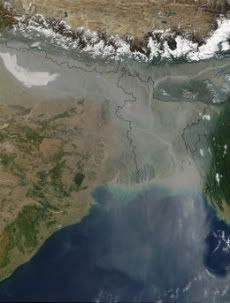New framework to account for effect of aerosols on precipitation
 A group of scientists affiliated with the International Geosphere-Biosphere Programme (IGBP) have proposed a new framework to account more accurately for the effects of aerosols on precipitation in climate models. Their work appears in the 5 September issue of Science magazine. Understanding the effects of aerosols on precipitation is of key importance to better assess the risks of flooding, drought and the availability of water for agriculture.
A group of scientists affiliated with the International Geosphere-Biosphere Programme (IGBP) have proposed a new framework to account more accurately for the effects of aerosols on precipitation in climate models. Their work appears in the 5 September issue of Science magazine. Understanding the effects of aerosols on precipitation is of key importance to better assess the risks of flooding, drought and the availability of water for agriculture.The increase in atmospheric concentrations of man-made aerosols — tiny particles suspended in the air — from such sources as transportation, industry, agriculture, and urban land use not only poses serious problems to human health, but also has an effect on weather and climate.
Recent studies suggest that increased aerosol loading may have changed the energy balance in the atmosphere and at the Earth’s surface, and altered the global water cycle in ways that make the climate system more prone to precipitation extremes.
It appears that aerosol effects on clouds can induce large changes in precipitation patterns, which in turn may change not only regional water resources, but also may change the regional and global circulation systems that constitute the Earth’s climate.
The proposed framework improves scientists’ ability to simulate present and future climates by integrating, for the first time, the radiative and microphysical effects of aerosols on clouds. The radiative effects of aerosols on clouds mostly act to suppress precipitation, because they decrease the amount of solar radiation that reaches the land surface, and therefore cause less heat to be available for evaporating water and energizing convective rain clouds. Microphysical effects of aerosols can slow down the conversion of cloud drops into raindrops, which shuts off precipitation from very shallow and short-lived clouds.
Model simulations suggest that this delay of early rain causes greater amounts of cloud water and rain intensities later in the life cycle of the cloud. This suggests that rain patterns are shifting, leading to possible drought in one area and flooding downwind in another area. In addition, greater cooling below and heating above leads to enhanced upward heat transport. Model simulations have shown that greater heating in the troposphere enhances the atmospheric circulation system, shifting weather patterns due to changes in convective activity.
Investigations of aerosol/precipitation effects are especially relevant to policy issues, as effects on the hydrological cycle may affect water availability, a great concern in many regions of the world:
 energy :: sustainability :: biomass :: bioenergy :: aerosols :: precipitation :: drought :: flood :: water cycle :: climate change ::
energy :: sustainability :: biomass :: bioenergy :: aerosols :: precipitation :: drought :: flood :: water cycle :: climate change :: The IPCC, in its latest climate change assessment report, declared aerosols to be "the dominant uncertainty in radiative forcing (a concept used for quantitative comparisons of the strength of different human and natural agents in causing climate change)”. Therefore, aerosols, clouds and their interaction with climate are still the most uncertain areas of climate change and require multidisciplinary coordinated research efforts.
To that end, authors of the Science article are participating in a new, international research project designed to study the connections between aerosols, clouds, precipitation and climate (ACPC project). The project will bring together an international multidisciplinary group of scientists from the areas of aerosol physics and chemistry, cloud dynamics, and cloud microphysics under theauspices of two international research programmes, the International Geosphere-BiosphereProgramme (IGBP) and the World Climate Research Programme (WCRP).
Picture: aerosol contamination over Northern India and Bangladesh. Credit: Wikimedia Commons.
References:
Daniel Rosenfeld, Ulrike Lohmann, Graciela B. Raga, Colin D. O'Dowd, Markku Kulmala, Sandro Fuzzi, Anni Reissell, Meinrat O. Andreae, "Flood or Drought: How Do Aerosols Affect Precipitation?", Science 5 September 2008: Vol. 321. no. 5894, pp. 1309 - 1313, DOI: 10.1126/science.1160606
 --------------
--------------
 Mongabay, a leading resource for news and perspectives on environmental and conservation issues related to the tropics, has launched Tropical Conservation Science - a new, open access academic e-journal. It will cover a wide variety of scientific and social studies on tropical ecosystems, their biodiversity and the threats posed to them.
Mongabay, a leading resource for news and perspectives on environmental and conservation issues related to the tropics, has launched Tropical Conservation Science - a new, open access academic e-journal. It will cover a wide variety of scientific and social studies on tropical ecosystems, their biodiversity and the threats posed to them.









0 Comments:
Post a Comment
Links to this post:
Create a Link
<< Home